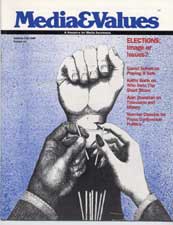Democracy Requires Access to Media Alternatives
|
This article originally appeared in Issue# 44
|
Regardless of the candidate/issue covered or the medium covering it, the 1988 presidential election represents journalism at its worst. Each television news broadcast appears to be campaigning as hard as the candidates for its share of the audience. Except for independent community stations, radio concentrates "all the news" in five-second bursts and rarely deals with substantive issues. The daily newspapers are all caught up in the headline/deadline syndrome. Although some magazines have managed intelligent discussion of election issues, most concentrate on pseudo-psychoanalytical personality pieces or rehashed strings of headlines disguised as in-depth reporting.
With the clichés and the criticisms magnified as never before, what is not being covered is a long list– real issues starting with war and peace, homelessness and unemployment, and ending with the rising drug crisis. Most of all, what we're not hearing about are the attitudes of the candidates themselves. How will they respond in times of crisis? Whom will they be likely to tap as key advisers? In what areas of policy are they most likely to be outstanding leaders or ineffective bureaucrats? In a year in which the First Lady's role in influencing policy is clearer than ever before, we're not even finding out how candidates' wives will influence them. Despite this dismal record, I can point to some notable– and instructive– examples of quality election coverage. First, thanks to the combined absence of rigid formats and corporate ownership/ sponsorship, or other control, community radio does the best job of letting the candidates speak for themselves.
"Alternative media will change in response to the political climate, help change that climate by their activist character and, having done so, change again. They are essential tools in the continuing task of reinventing America."
– David Armstrong
Second, a variety of publications with more specialized audiences have shed some welcome light by focusing on specific aspects of the current presidential campaign. For example, Sojourners, an independent Christian monthly, grappled with the much-greater-than-usual role religion played in shaping the 1988 election and its candidates. Black Enterprise, a monthly business magazine, interviewed candidates on issues of primary importance to both business and Afro-American community interests. (Interestingly, both George Bush and Jack Kemp declined to be interviewed.) There are other bright spots, but in order to get a sense of the candidates and the breadth of the issues a voter must read many publications throughout the campaign period.
How can the media be made more responsive? Deregulation and greater corporate ownership have all but ended public access to broadcasting, but listener/reader/viewer letters and calls can still help. So can support for various glass-roots and alternative media outlets. But the ownership and policies of the media organizations, the unwritten and sometimes unwitting self-censorship of journalists in the corporate media environment, and the lack of economic and human resources at the more enlightened media, make the task a very difficult one at best.
Election time or not, in the short run the best way of obtaining information lies in supporting the smaller, grassroots media through memberships, subscriptions, contributions, and volunteer work, and by sponsoring grants and fellowships for investigative journalism.
Ultimately, grassroots support of alternative media is hardly enough. Over the long haul, election of a president willing to swim against the deregulatory tide and give control of the public airwaves back to the people would be a crucial step toward true media reform People who care about the media need to consider the candidate they support as well as what they read, watch and hear.



